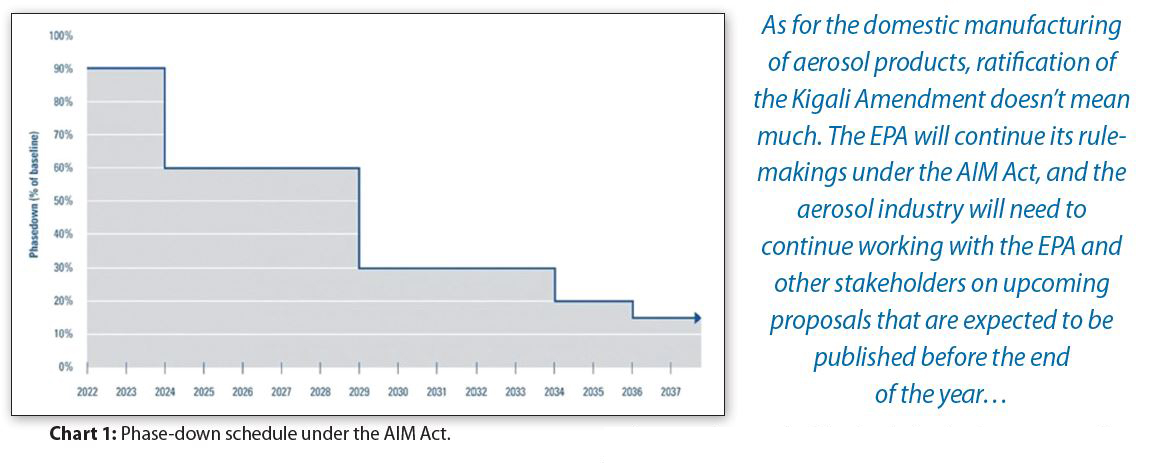Written on: November 1, 2022 by Nicholas Georges
On Sept. 21, the U.S. Senate ratified the Kigali Amendment to the Montreal Protocol on Substances that Deplete the Ozone Layer. The U.S. is now one of nearly 140 parties that have agreed to the Amendment to globally phase down the production and consumption of hydrofluorocarbons (HFCs).
Under the Kigali Amendment, countries must decrease their use of HFCs based on a timeline. For example, developed countries, such as the U.S., must reduce the use of HFCs by 85% by 2036, compared to 2011–2013, which should sound somewhat familiar to companies in the aerosol industry.
The U.S. has already implemented an HFC phase-down program under the American Innovation & Manufacturing (AIM) Acti, which directs the U.S. Environmental Protection Agency (EPA) to decrease the production and consumption of HFCs to 15% of the baseline by 2036. Chart 1ii shows the expected reduction schedule compared to baseline levels.

You may be wondering, first, if Congress has already directed the EPA to phase down the use of HFCs in the same timeline, why ratify the Kigali Amendment? Second, what impact does ratification of the Kigali Amendment have on the U.S. aerosol industry?
While the ratification of the Kigali Amendment proves that the U.S. is committed to combating climate change, there are also international legal consequences. Once the President submits U.S. ratification and the U.S. becomes party to the amendment, the U.S. will not be subject to certain HFC trade restrictions that come into force in 2033. Specifically, Article 4 of the Kigali Amendment restricts parties to the Montreal Protocol from trading controlled substances with countries that have not ratified the amendment.
Furthermore, as part of the ratification, Congress has directed the Secretary of State to propose that China be classified as a developed country and be subject to the same timeline as the U.S. and other developed countries.
As for the domestic manufacturing of aerosol products, ratification doesn’t mean much. The EPA will continue its rulemakings under the AIM Act, and the aerosol industry will need to continue working with the EPA and other stakeholders on upcoming proposals that are expected to be published before the end of the year.
The first proposal will be for the allocation allowance rule for fiscal year 2024 and beyond. The first HFC Allowance Allocation & Trading Program ruleiii established an HFC allowance allocation and trading system to phase down HFCs, but only for fiscal years 2022 and 2023. As of Jan. 1, 2024, the phase-down will decrease from 90% of the baseline to 60%. At this time, we will also see whether or not imported finished products are included in the allocation methodology (only bulk HFCs are subject to allocation under the current rule).
The second proposal will be for the “Technology Transition” portioniv of the AIM Act. The EPA—either on its own initiative or petitioned by a stakeholder—will restrict, either fully, partially or on a graduated schedule, the use of HFCs in sectors or subsectors where they are used. Last year, the EPA grantedv 11 petitions (10 full and one partially) under this section of the AIM Act; it has until Oct. 7, 2023, to finalize a rule. HCPA will submit comments to the EPA on both proposed rules when they are published.
If you have questions on the U.S. ratification of the Kigali Amendment or any aspect of the AIM Act, please contact me at ngeorges@thehcpa.org. SPRAY
i 42 USC 7675
ii Available here
iii 86 FR 55116
iv Subsection (i)
v 86 FR 57141